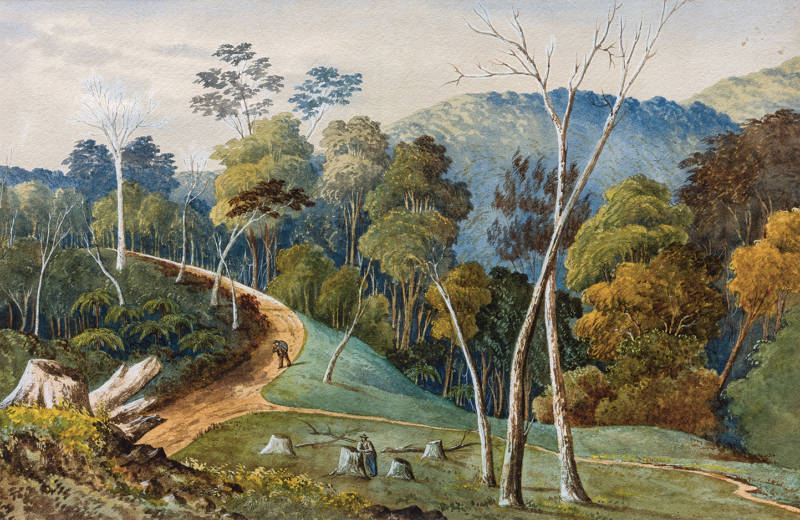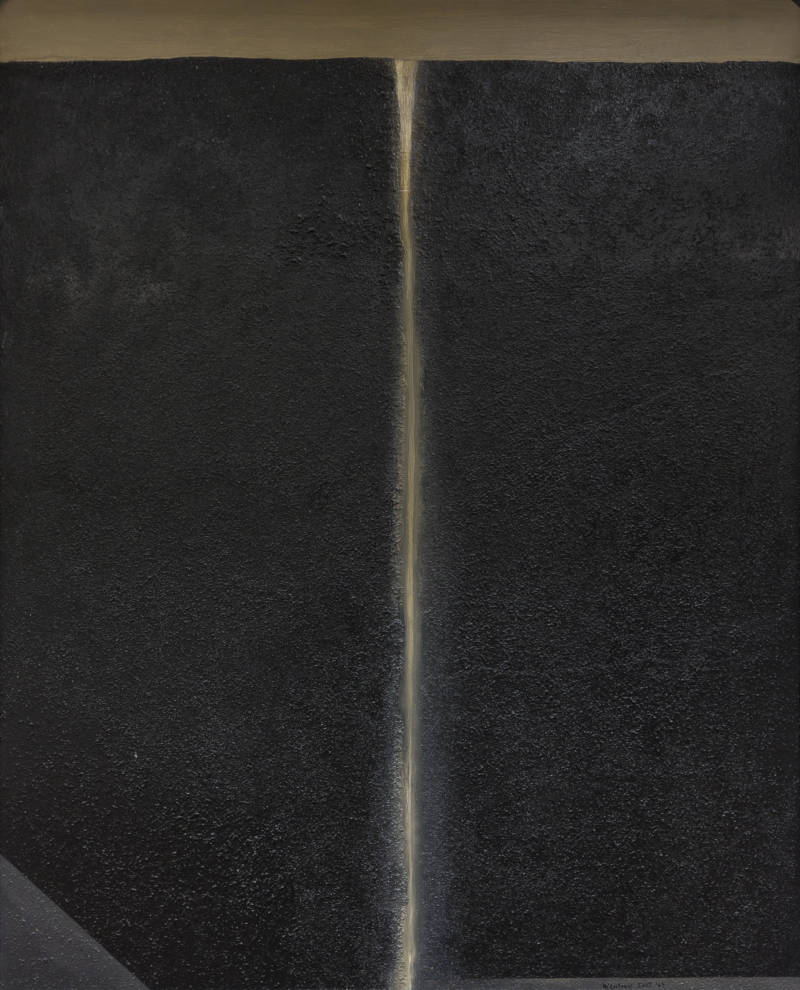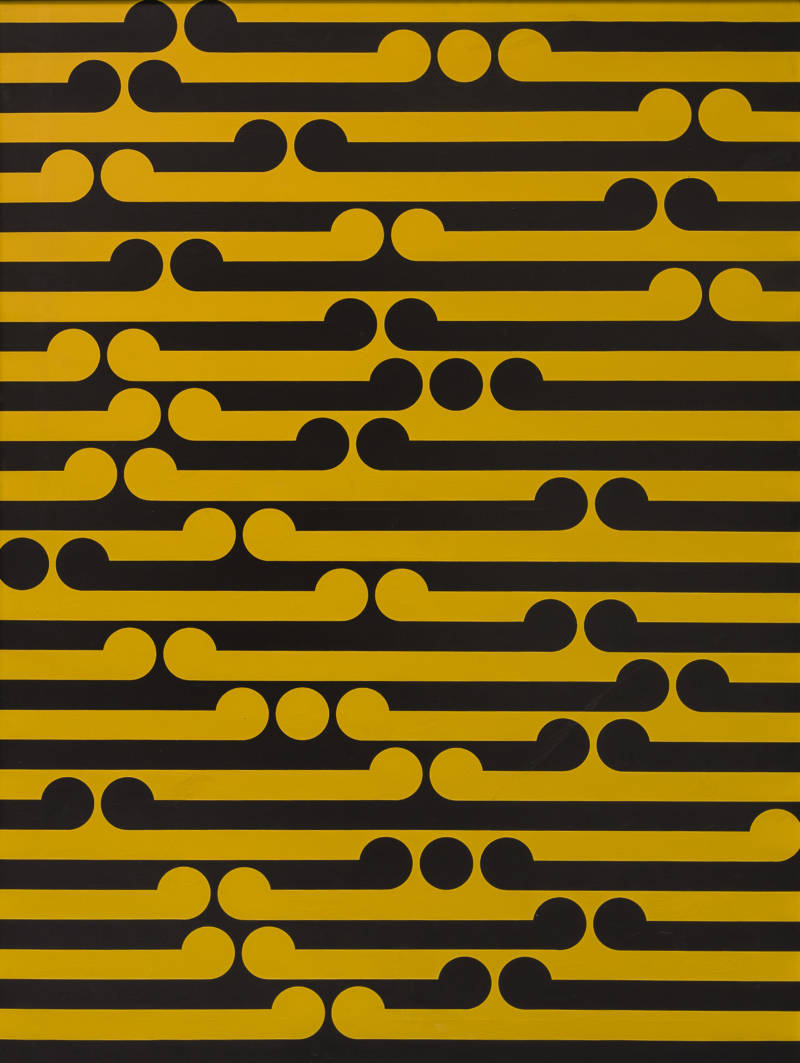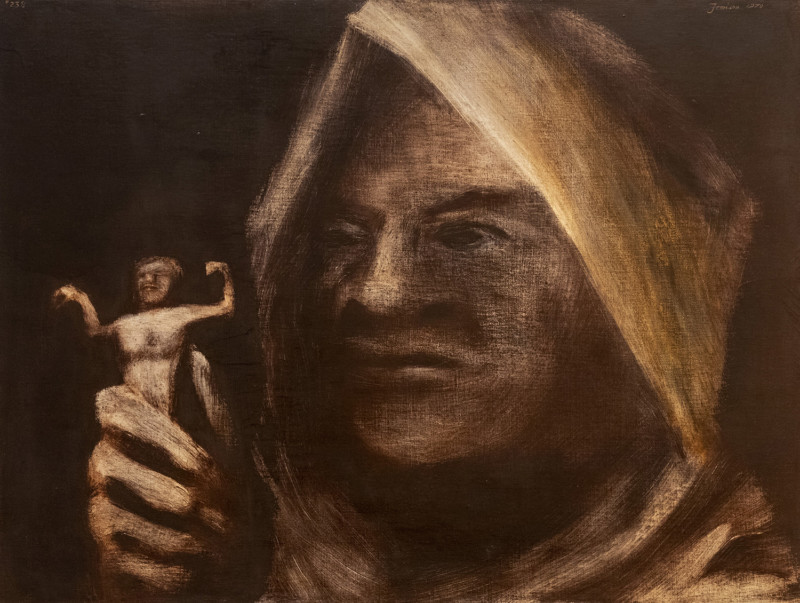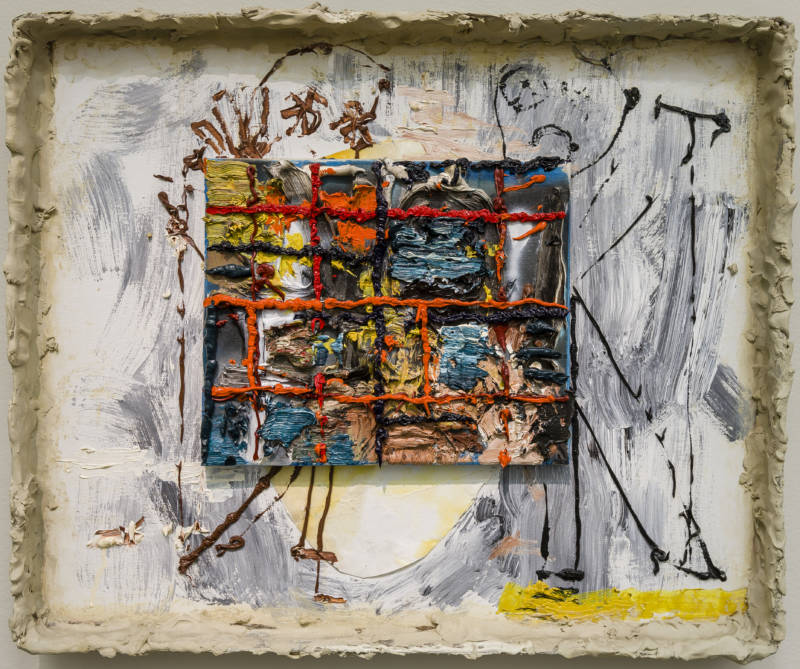History
The origin and evolution
of the Fletcher Trust Collection
It is still reasonably common for corporate or professional offices in New Zealand to display paintings, sculptures or ceramics in their premises. Invariably staff members develop a lively interest in what hangs on their own office walls. By this exposure many are encouraged to think about aesthetic values, to pursue an interest in art and to discover that, far from being an area of mystery, the visual arts have much to contribute to their lives. With these values in mind a collection of New Zealand paintings was initiated in the Fletcher group of companies in 1962.
Before 1962, the panelled plywood walls of the offices of what was then called Fletcher Holdings were sparsely decorated. The company’s Penrose Head Office, designed by the architect Henry Kulka in 1940, exhibited architectural qualities of great simplicity and elegance; it was not intended that paintings should form part of the decorative scheme. Such was also generally the case in Head Offices throughout New Zealand although many chose to exhibit the ubiquitous hand-coloured White’s Aviation aerial landscape photographs.
The story of the Fletcher Holdings’ collection’s almost accidental beginning belies the status today of the Fletcher Trust Collection as New Zealand’s preeminent collection with corporate origins. In early 1962, Sir James Fletcher II, then J. C. (Jim) Fletcher, was telephoned by Peter Webb, who at that time employed by the Tāmaki Makaurau art auctioneers Geo. Walker Limited. The purpose of his call was to inquire whether Fletcher Holdings would be interested in acquiring four New Zealand watercolours by the 19th-century painter J. B. C. Hoyte. Accompanied by George Fraser, Managing Director, Fletcher Group Services, Sir James inspected the works at Walker’s Queen Street premises and agreed to purchase all four for a price which has gone down in legend as ‘₤300 or thereabouts’.
The four paintings, two rural scenes in the Coromandel and two of the town of Coromandel, were hung in the Fletcher Holdings dining room. According to George Fraser’s introduction to the 1981 Fletcher Collection catalogue, two things then happened almost simultaneously: an interest was created at Fletcher’s in early New Zealand art and it became known to dealers that the company was interested in purchasing such works. From then on buying continued on a modest scale. George Fraser, chief encourager and guardian of the growing collection, formed an unofficial art committee consisting of Sir James and Lady Fletcher and their son, Hugh Fletcher.
By 1967, when the company’s new premises at Fletcher House, 810 Great South Road, Penrose, was nearing completion, a worthwhile collection of 19th-century and early-20th-century New Zealand art had been assembled. However, the size of the new premises determined that a greater number of paintings would shortly be required.
The next initiative came from Peter Bromhead, at the time engaged as Interior Designer of Fletcher House. It was he who, using a specially constructed model, persuaded the architect Hugh Phillips and the Building Committee to consider abandoning the dark wood panelled walls traditionally used for executive floors and instead to permit white walls which could then be advantageously hung with contemporary paintings. Peter Bromhead was instructed to recommend some contemporary paintings by major New Zealand artists for the purpose. In this initiative, he was greatly assisted by J. H. Churton, General Manager and Director, Fletcher Trust and Investment.
In retrospect, Bromhead could hardly have done better than Colin McCahon’s 1965 July Waterfall and Gordon Walters’ 1967 koru painting Tahi, both of which were immediately purchased. These two paintings formed the basis of a collection of contemporary New Zealand painting, which has been steadily added to ever since. At first, the demand for new works was so great that limited edition prints by contemporary artists were bought to ensure that all employees were able to share in the new experience. Those who preferred colonial painting to contemporary art had their taste accommodated either with the Alexander Turnbull Library’s reproduction prints or by Avon prints.
In addition, a set of the so-called ‘Duperrey prints’ was purchased. These record the 1824 ‘Voyage autour du monde’ of the Coquille under the command of Louis Isidore Duperrey. Original sketches made by the crew member/artist Jules Louis Lejeune were painted by the artist Antoine Chazal, then made into hand-coloured engravings by Ambroise Tardieu, which were published in 1826. Those Duperrey prints recording the native birds and fish of places visited during the voyage were donated by Fletcher Holdings to Otago University after Fletcher Construction had completed the University’s new library building in 1965. The remaining works formed the basis of a collection at Penrose of historic New Zealand prints, which has also continued to grow.
From 1967 to 1981, paintings by early artists who visited this country were collected, as well as paintings by those who settled here. New Zealand-born artists across the whole spectrum of styles and periods were collected. Younger emerging artists were not neglected, nor were works by such eminent foreign figures as Petrus van der Velden and, after the turn of the century, Claus Fristrom, James McLauchlan Nairn, Girolamo Nerli, and later Rudolf Gopas, whose impact as teachers was so significant.
Buying for the collection was done at dealer galleries and at auction, where Lady Fletcher received a deserved reputation for her discerning eye and spirited bidding. Her special coup in securing Alfred Sharpe’s large watercolour Sunset on the Puhoi River, Wenderholm at Cordy’s in 1971 is far from a rare instance of a choice purchase for which she was responsible.
In the late 1970s, Fletcher Holdings and another major public company, Challenge Corporation, had acquired between them a majority shareholding in the Tasman Pulp and Paper Company Limited and in 1981 the three companies merged to become Fletcher Challenge Limited. This had significant implications for the Fletcher Collection as it was now joined by the smaller Challenge Collection, which had been existence since 1965.
It owed its origin to two men, Sir Ronald Trotter and Jack Hodgetts, whose decision it was to enhance the new 26-storey Challenge House on The Terrace, Te Whanganui-a-Tara, with original paintings. Over the following ten years, a portfolio of 120 paintings was acquired, mostly but not exclusively landscapes, considered most appropriate for a largely rural company. Later, Margaret, Lady Trotter, added a large contemporary collection of paintings to the Challenge Collection, many of which were hung in the offices of subsidiary companies as well as in the company’s Head Office.
Sir Miles Warren’s 1979 design brief for the new Challenge House included the provision of light, temperature and humidity controls suitable for the hanging of paintings. Lady Trotter was put in charge of buying additional works in preparation for the move. Fletcher Challenge House, Wellington, as this building was known on its completion, was one of the first examples in New Zealand of an office building being specifically designed to accommodate works of art.
From 1981 until 1991, two parallel Fletcher collections were maintained. The one in Tāmaki Makaurau was operated under the consultancy of Petar Vuletic of Petar/James Gallery and later John Gow of John Leech Gallery, working closely with Sir James Fletcher, George Fraser, and an unofficial art committee. In Te Whanganui-a-Tara, the collection continued to grow under the direction of Lady Trotter.
During Vuletic’s consultancy with the Fletcher Collection in Tāmaki Makaurau, from 1973 until 1986, a significant collection of abstract painting by contemporary New Zealand artists was put together. Works by senior abstract artists Milan Mrkusich and Gordon Walters, as well as younger practitioners, such as Gretchen Albrecht, Stephen Bambury, Robert McLeod, Ian Scott, Geoff Thornley, and Mervyn Williams increasingly made Fletcher House a veritable gallery of contemporary New Zealand art. The persuasive advocacy of Vuletic, well known throughout the country for his insightful and well-argued views about New Zealand art history, was crucial to this development.
In Te Whanganui-a-Tara, during the ten year period of her curatorship, Lady Trotter bought widely and adventurously in the contemporary area. She travelled throughout the country visiting dealer galleries and artists’ studios in search of the finest representative work by established major and emerging artists. Under her guidance, important works by McCahon, Tony Fomison, and Ralph Hotere were added to the collection, as were significant works by abstract painters.
It was never her policy to avoid a fine but difficult work when the purchase of a superficially easier one might have been more immediately pleasing. The value of her curatorial policy is evident on the company’s walls to this day. Close working relationships were formed with the staff of the National Art Gallery (later the Museum of New Zealand Te Papa Tongarewa) and the Auckland City Art Gallery (later Auckland Art Gallery Toi o Tāmaki).
Among those consulted on the building of the growing collection in Te Whanganui-a-Tara were artist and art historian Melvin Day and art auctioneer Peter Webb, as well as all major art dealers, but particularly Elva Bett, Denis Cohn, and Rodney Kirk Smith. In 1987, it was decided to combine the dispersed company offices in Tāmaki Makaurau and Te Whanganui-a-Tara into a single global headquarters in a refurbished Fletcher Challenge House at Penrose. The merging of the two painting collections was an inevitable consequence of the decision.
On the death of George Fraser in 1986, the Fletcher Collection lost one of its driving forces. He had worked tirelessly to give the paintings he had collected a high profile among employees. Although like everyone else he had his favourites among artists and individual paintings, he always encouraged a tolerant response to the new. He insisted, emphatically when necessary, that offices furnished with fine paintings be kept tidy and unadorned with personal photographs or calendars.
From 1986 to 1991, Lady Fletcher curated the Tāmaki Makaurau collection, with Gow acting as consultant. His opinion was frequently sought by Sir James and Lady Fletcher, who had long kept a sharp eye on art auction catalogues during a period of art market buoyancy in New Zealand, albeit one which came to an abrupt halt in October 1987. Despite this, the company’s interest in art purchasing continued. By late 1988, the refurbished Fletcher Challenge House was fully occupied. Andrew Drummond’s impressive large-scale sculpture Resting Limbs (From Another Archeology) was permanently installed in the Reception Area on the ground floor.
In anticipation of the merging of the two collections in Penrose, it was decided in 1990 to form an Art Committee to administer it. The members of the committee were Sir James Fletcher (Chairman) and three of the company’s chief executives: John Hood, Michael Andrews, and Neville Darrow, later succeeded by Bill Falconer. Their first task was to write a mission statement for the Fletcher Challenge Art Collection and to make the decision to appoint a full-time curator.
By 1 July 1991, paintings formerly in Te Whanganui-a-Tara had all joined their Tāmaki Makaurau counterparts on the walls at Fletcher Challenge House and in the new Penrose West complex. On that date, Lady Fletcher and Lady Trotter handed over their accumulated documentation of the art collection to a newly appointed curator, Peter Shaw. His responsibilities included cataloguing, loans, accessioning and de-accessioning of works, and the exhibition of all paintings. In line with Sir James Fletcher’s strongly held view that the paintings should not just operate as decorative items, the curator was charged with the task of staff art education using the collection as the primary source. In addition, following a suggestion by Chief Executive Hugh Fletcher, a policy of purchasing work by emerging New Zealand artists was instituted.
In a period that saw the dismantling of many of New Zealand’s corporate art collections, the Fletcher Challenge Art Collection continued to go from strength to strength. Holdings of works by major and established mid-period New Zealand artists were updated; the collection of work by emerging artists was enthusiastically continued; gaps in the collection were filled. Visitors continued to be welcomed, among them artists, gallery personnel, staff and family, and many guests of the company. A number of large-scale charitable functions involving art tours were held in Fletcher House.
In 2001, when Fletcher Challenge Limited was broken up as a corporation, the collection was renamed the Fletcher Trust Collection. Fletcher Building, one of the four divisions, remained headquartered at Penrose, and it is here that many of artworks continue to be displayed. The wider display of the collection fits within the Trust’s philanthropic objective to ‘promote New Zealand art through the display, exhibition, research, scholarship and the loan of paintings’.
Since 2002, a number of works have been on loan to the Government Houses in Tāmaki Makaurau and Te Whanganui-a-Tara. Other works are constantly travelling on loan as part of specially curated exhibitions initiated either by the Trust itself or by public art galleries. In line with founder Sir James Fletcher’s fervently held intention, the Fletcher Trust’s policy is that its collection, constituting a unique record of the whole history of New Zealand art, should continue to be seen by as many New Zealanders as possible.

